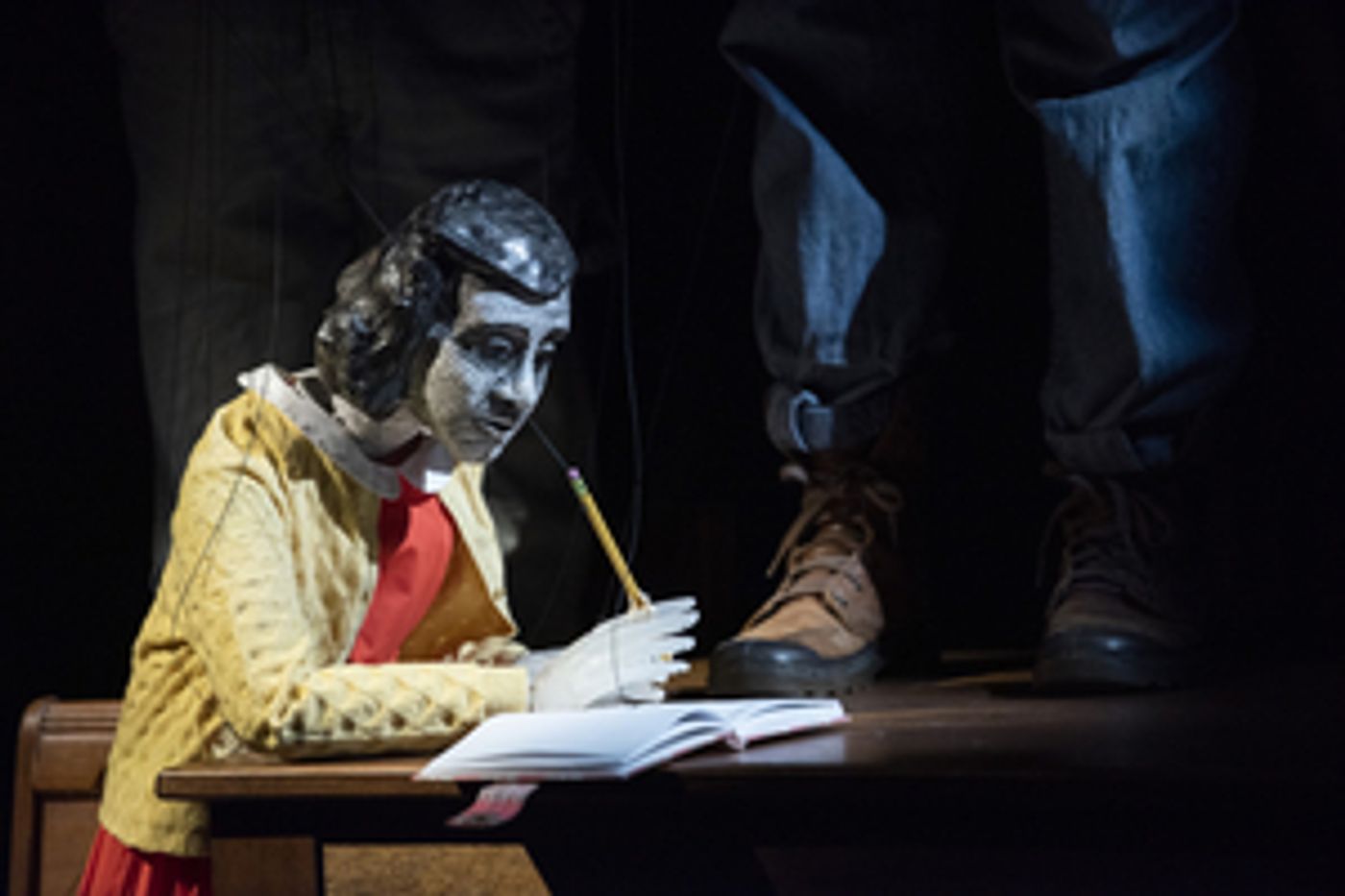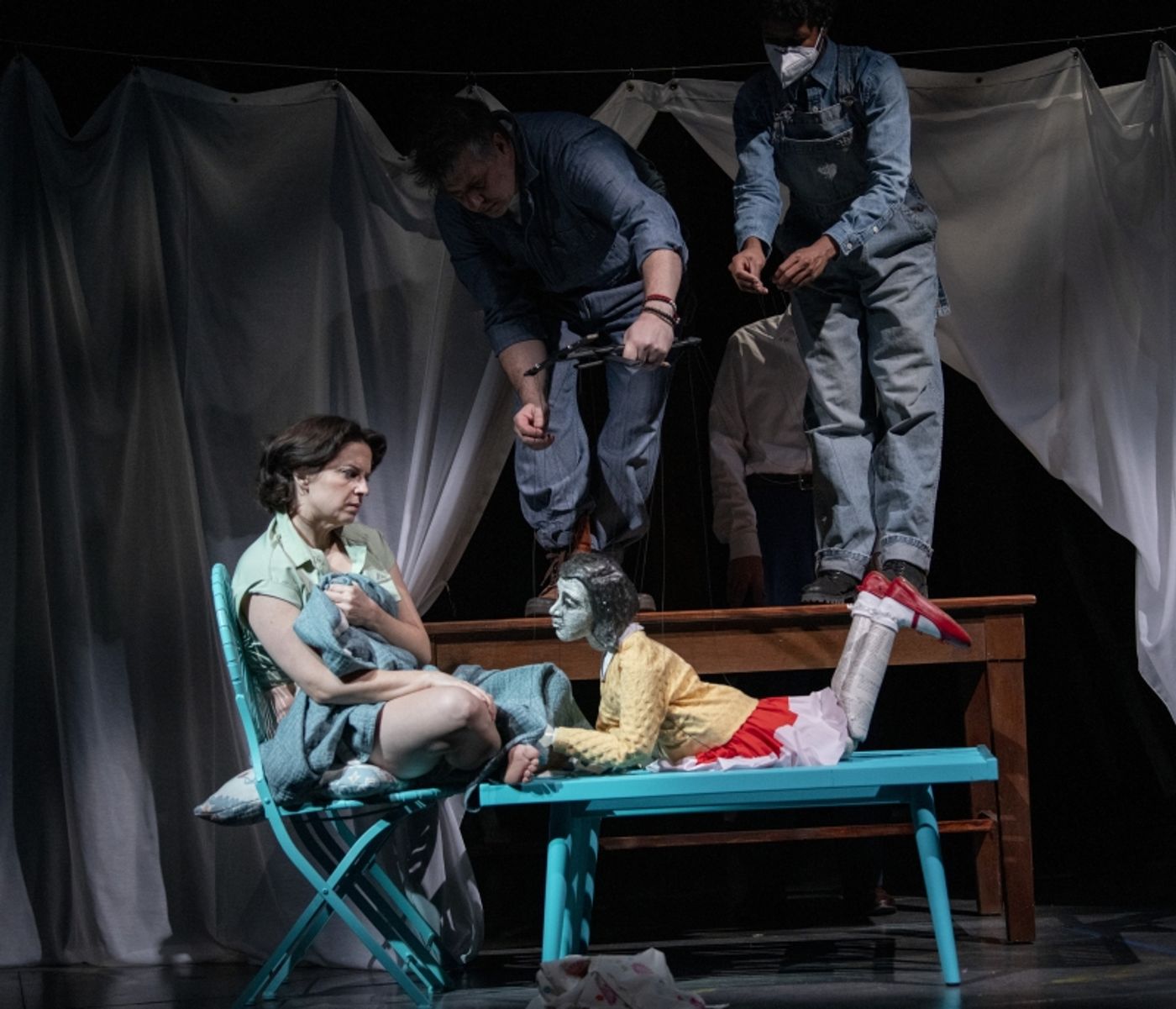Review: COMPULSION OR THE HOUSE BEHIND at Theater J
Who "owns" a story? Who has the right to it?

Who "owns" a story? Who has the right to it? Do stories get their value intrinsically, or from the telling? After all, part of what makes stories resonate is how we connect with them - so who do they really belong to?
These are some of the questions raised by Theater J's latest production, Compulsion or the House Behind, the fictionalized telling of the American publication of Anne Frank's diary, the legal battles behind the story's stage adaptation, and the toll an obsession can take on a person and those around them. It follows Sid Silver (based on the real-life author, Meyer Levin) as he works to help Otto Frank publish an English-language edition of Anne Frank's diary in the United States and create a stage adaptation; unfortunately, Silver's vision and that of Otto Frank, publishers, and producers soon diverge, and Silver digs in to claim his right to Anne's story.
Playwright Rinne B. Groff imagines a fictionalized telling of Silver's struggle based in large part on Levin's own works. She draws the title and structure (as well as the character name) from Compulsion, which was a different project Levin worked on around the same time as his struggles with the diary's adaptation played out. Like Levin, Groff fills in dramatized conversations between the known facts, building out the details in between. Based on Levin's writings, those of his wife (writer Tereska Torres), legal documents, and public discourse, Groff pieces together the events surrounding the publication of the diary and the production of the award-winning stage show. We watch as Silver loses his place in this process, and obsessively clings to the project, observing the impact on his family and the lengths to which he is willing to go to tell Anne's story his way. Groff also adds a dreamy element to the production; drawing again from Levin's own puppetry background, the play includes a puppet version of Anne Frank, who interacts with the various characters as well as acts out excerpts from her own writing.
Compulsion is also, incidentally, the most, well, Jewish show I've seen at Theater J over the years. The bigger questions that are actually discussed are more about what it means to be a Jew, how we tell our stories, and who gets to tell them. Silver's objections initially stem from his objection to removing Anne's "Jewishness" from the story - first, by having former First Lady Eleanor Roosevelt write the introduction (both because Ms. Roosevelt was not Jewish and because her husband's administration famously turned away the MS St. Louis, a boat of Jewish refugees who sought asylum), then later by removing references to Judaism that he puts in the early drafts of scripts. What makes this particularly interesting is the context - the Franks, despite their status as famous Jews today, were not exceptionally religious; indeed, their status as Jews only took the forefront of their identity when the Nazis deemed it so. Readers of Anne's diary are aware of her grapples with Judaism and faith, but they're notably quite different than those of a man like Levin/Silver, who authored numerous texts on Jewish identity. Furthermore, there is the inclusion of Miss Mermin, the savvy young editor at Doubleday who, amidst Silver's righteous rants, quietly reveals that she is not only Jewish, but exactly the same age as Anne would have been; her connection to Anne's diary and her own expression of Judaism are no less valid than Silver's, though he certainly doesn't see it that way when he accuses her of "passing." For readers who haven't experienced this firsthand, this is a common argument within the Jewish community, and has been for centuries - what is "Jewish enough" has been the source of many, many fights, including this one.

Philosophy aside, the pacing of the show does feel a bit off. Act I covers nearly a decade, from Silver's first meetings with Doubleday through his wife issuing an ultimatum for him to drop the lawsuits he filed against Otto Frank and producer Kermit Bloomgarden. In many ways, the act itself could be the full play, covering most of the notes necessary to tell the story itself. Although Act II covers the very real aftermath - an obsession that festers in secret, and the consequences of Silver achieving his ends - there isn't as much forward motion, and the two acts feel decidedly lopsided. Silver's descent from fan to fanatic in the first act feels abrupt and hurried - we don't see it build over time because we're only shown brief snapshots over the course of the decade, and the result is he comes off as angry, difficult, and hyperbolic almost from the start (it's hard to imagine Otto Frank putting his trust in a man who would, only a few scenes later, equate him with the Nazis). Likewise, we see his harsh treatment of the women around him - Miss Mermin at Doubleday and his wife at home - without any ascension, so it's difficult to buy into the relationships as established. In contrast, Act II almost feels empty, covering a longer period of time but significantly less of the story action; while it's given the room to breathe, it almost feels like a long epilogue rather than a continuation of the story from Act I. Though, in fairness, that space also allowed for more artistic elements to come forth: In the first act, the puppet version of Anne (created and performed by Matt Acheson) feels under-utilized, appearing in occasional scenes but often simply for repeating her well-known affirmation: "In spite of everything, I still believe that people are really good at heart." In Act II, though, we get to see deeper interactions between the puppet and the characters, building out their relationship to her and her story. I do want to note (especially for those who know I have a tenuous relationship with puppets) that Acheson's puppet was quite striking. In addition to period-appropriate clothing, Anne's marionette featured skin created by pages of her writing, showing that her puppet was the literal embodiment of her diary, and is noticeably small, emphasizing that she was, in fact, a child. Additionally, the puppet's range of movement and the emotionality expressed by the puppeteers (Acheson, along with Eirin Stevenson) was incredibly impressive.
Alongside the beautifully detailed puppet, the live actors hold their own as well. Marcus Kyd plays an array of characters, ranging from the eerily similar suits at Doubleday (Mr. Thomas, Mr. Harris, and Mr. Ferris) to the rougher Israeli Defense Forces representative, Mr. Matzliach (with an assist from Tonya Beckman's solid dialect coaching). Paul Morella serves as the driving force of the show as Sid Silver, perfectly conveying Silver's passion, obsession, and sense of loss. Kimberly Gilbert, as Miss Mermin and Mrs. Silver (also brought to life with the assistance of Beckman), is easily a standout, with two distinct characters showing off the actress's range; while Sid is the main driver of the story, it's Gilbert's characters who are the true forces - Miss Mermin, who pushes Anne's story forward despite his insistence that he has a claim on it, and Mrs. Silver, for showing the audience (if not Sid) the true price of his obsession. Indeed, the confrontation between Gilbert's Mrs. Silver and Anne is one of the show's best scenes. It's in moments like that where Director Johanna Gruenhut's skill shines as well, creating a balanced, engrossing stage. I'd also be remiss if I didn't express my absolute love for Sarah Cubbage's gorgeous costumes; as a fan of vintage clothing, I found myself wanting to steal Gilbert's entire wardrobe. In fact, the only technical element I was disappointed by was Nephelie Andonyadis' set design - I've come to greatly enjoy the elaborate, detailed sets Theater J has presented over the years, and found the decision to utilize a barer stage a bit disappointing and not fully necessary (unless it was due to Covid-related shortages, in which case I'll retract this critique).

While I enjoyed Compulsion, it still feels like it falls a bit short - and that it realizes it too. There are so many moments where it feels like we're on the brink of something, and the show shies away at the last second. Notably, when Mrs. Silver confronts Anne in her dreams and interrupts Anne's reminiscence of her father's experiences and feelings to ask about Anne's feelings, rather than acknowledge that the entire focus within Sid's obsession, the lawsuits, and even her own discomfort is less about the girl than about the story the men around her legacy are telling, the show brushes this aside with Anne insisting that some things are private. Which, while a valid point about Anne's experiences, feels like it misses the broader mark for a show that is not really about Anne Frank but about the men who speak for her.
In truth, this brink is often reached and surrendered when gender comes up within this production. While the show takes place primarily in the mid-20th century, it's still frustrating to see how women are regarded with little acknowledgement of that treatment. Sid is admonished by Williams (another of Kyd's characters) with a cutting, "You can't talk me the way you talk to women," and yet the line goes unremarked upon and isn't revisited. Likewise, we're shown at numerous points that Sid has a tendency to both admire and talk down to the women in his life, who are also, incidentally, significantly younger than him. Even his obsession with Anne is less about her and more about his projection of her; when Mrs. Silver threatens to leave Sid, it's not a divorce or separation she turns to, but suicide, as though she's also aware that he has a stronger affinity for a dead woman upon whom he can project his own ideals rather than a live one who can contradict him.
Compulsion or the House Behind is a good show, with a strong creative team and an immensely talented cast, but it's also a flawed one. With pacing issues and a shyness about fully facing the questions it raises, it's often a frustrating production. But it's a thought-provoking one for that same reason.
Compulsion or the House Behind is playing at Theater J at the Edlavitch DCJCC through February 20th. Run time is approximately 2 hours and 5 minutes, with one intermission, and tickets are available for in-person (including socially-distanced seating on designated dates) as well as streaming experiences on the Theater J website. Trigger warnings for discussions of suicide, war, and the Holocaust.
Reader Reviews
Videos

